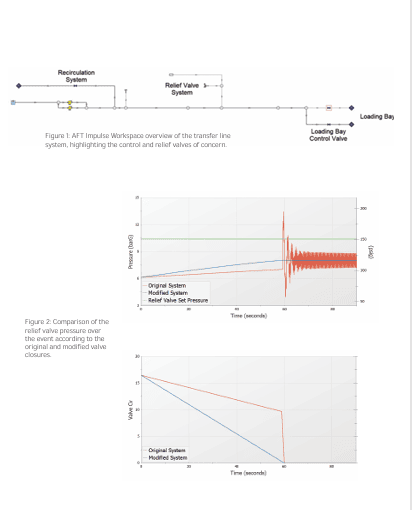In the world of petrochemical processing, the safety and efficiency of fluid handling systems are critical. One common challenge faced during petrochemical loading operations is pressure surges, which can cause severe issues like system vibrations, noise, and even equipment damage. This blog post discusses how engineers from Ingenero Technologies, using AFT Impulse, successfully mitigated a potentially hazardous pressure surge during a truck loading operation.

The Challenge: Sudden Pressure Surge During Truck Loading
Ingenero Technologies was tasked with resolving a significant issue for their client, who experienced a dangerous pressure surge near the end of the truck loading process. This surge resulted in pressures exceeding 13.2 barg (191 psig), which led to loud noise, system vibration, and relief valves chattering downstream of the pumps.
The loading system consisted of two tanks, each with its own pump and transfer lines. Recirculation and relief valves were installed to redirect flow and protect the pumps during reduced flow conditions. The surge typically occurred when the truck was almost fully loaded, leading to a concern over the closing of the control valve in the loading bay.
Initial Analysis with AFT Impulse
Ingenero’s engineers, Mohommed Ilyas Mullani and Swapnil Paingankar, were tasked with conducting a root cause analysis using AFT Impulse, a powerful tool for simulating transient flow phenomena like pressure surges. They developed a simplified model of the system based on P&IDs, isometric drawings, pump curves, and fluid properties. The model was tuned to match operational data with a 10% accuracy margin for steady-state conditions.
Their primary focus was to determine whether the recirculation system was working as intended and whether the closing of the loading bay control valve was causing the surge.
Key Findings and Solutions
1. Recirculation System Analysis:
Although the recirculation system was suspected of reacting too late, tests with continuous recirculation failed to mitigate the surge. This indicated that poor recirculation was not the root cause.
2. Valve Closure Behavior:
The engineers turned their attention to the control valve closure pattern. By analyzing the transient effects of the valve’s closure using AFT Impulse, they discovered that the surge was directly related to how the valve was being closed. A modified valve closure pattern was developed, which reduced the surge pressure to below the relief valve set point, effectively solving the issue.
Post-Implementation Results
After implementing the modified valve closure strategy, the client observed a significant reduction in pressure surge during the loading process. A worst-case scenario test, with flow from both tanks simultaneously, showed a pressure surge of 10 barg (140 psig), closely matching the predictions made by the AFT Impulse model. This validation confirmed the accuracy of the simulation and the effectiveness of the solution.
Conclusion
This case study demonstrates how AFT Impulse can be an invaluable tool in identifying and mitigating pressure surges in petrochemical loading systems. By analyzing transient flow behaviors and adjusting valve operations, engineers can prevent dangerous surges, protect equipment, and improve overall system reliability.
Ingenero Technologies' success in this project showcases the importance of leveraging advanced simulation tools for ensuring safe and efficient operations in the petrochemical industry.

